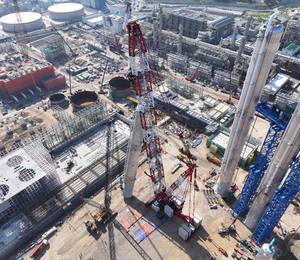Light Rail Manila Corporation (LRMC) has officially opened Phase 1 of the Light Rail Transit Line 1 (LRT-1) Cavite Extension project. The inauguration ceremony took place on 15 November 2024 at the LRT-1 Dr. Santos (formerly Sucat) Station in Paranaque City, attended by Philippine President Ferdinand R. Marcos Jr.
The new rail line started its commercial operation on 16 November, incorporating five new stations: Redemptorist – Aseana, Manila International Airport (MIA) Road, Parañaque Integrated Terminal Exchange (PITX), Ninoy Aquino Avenue and Dr. Santos.
LRMC, together with Bouygues Travaux Publics as the engineering, procurement and construction (EPC) contractor, commenced the civil works for the LRT-1 Cavite Extension project in September 2019.
With the completion of Phase 1, the LRT-1 line has been extended from 20.7 km (with 20 stations) to 27 km. It covers five cities, namely Quezon City, Caloocan, Manila, Pasay and Paranaque. When fully completed, the entire line will feature 32.4 km in length with a total of 28 stations.
The LRT-1 extension is an important public-private partnership (PPP) project in the Philippines, which aims to significantly improve connectivity to the south of Metro Manila. It will also decongest major thoroughfares in the area by servicing an additional 80,000 passengers to LRT-1’s daily ridership of 323,000.
Long-term commitment
Speaking at the inauguration ceremony, President Marcos said the LRT-1 Cavite Extension “has been a long time in the making – spanning five administrations, starting with President Estrada, to President Arroyo, President Aquino, President Duterte, and now, to mine.”
He pointed out that the government should leverage the Public Service Act to remove the 40% cap on foreign investment in railways to attract foreign investments in the transport sector. He further mentioned that the PPP hybrid model on this project serves as a template for future investments.
President Marcos also recognised that some of the ongoing transport projects may not be completed under his leadership as these long-term endeavours extend beyond administrations. “This is the nature of railway development and of any large-scale development; this is not a short-term endeavour. It requires patience, persistence, and passion and commitment that extends beyond immediate timelines,” he said.
Various key railway projects are currently being undertaken by the government. These include the Unified Grand Central Station, Metro Manila Subway Project, MRT-7, North-South Commuter Railway, MRT-4, and the Philippine National Railways South Long Haul, among others.
“Our journey towards a more seamless and modernised public transportation system does not end here,” affirmed President Marcos, highlighting the importance of having reliable and efficient rail networks in the country. “We are committed to building station after station, reaching as far and as fast as our people’s needs dictate.”
All images: Light Rail Manila Corporation
*Below is a video of the project during construction.













